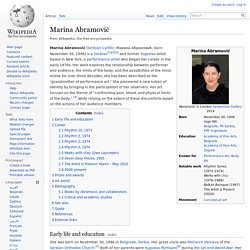

Internet Sacred Text Archive Home. New Atlantis. New Atlantis is a utopian novel by Sir Francis Bacon, published in Latin (as Nova Atlantis) in 1624 and in English in 1627.

In this work, Bacon portrayed a vision of the future of human discovery and knowledge, expressing his aspirations and ideals for humankind. The novel depicts the creation of a utopian land where "generosity and enlightenment, dignity and splendour, piety and public spirit" are the commonly held qualities of the inhabitants of the mythical Bensalem. The plan and organisation of his ideal college, Salomon's House (or Solomon's House), envisioned the modern research university in both applied and pure sciences. Plot summary[edit] Zecharia Sitchin - ancient astronauts. "Nibiru (hypothetical planet)" redirects here.
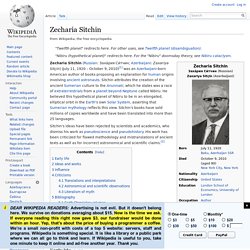
For the "Nibiru" doomsday theory, see Nibiru cataclysm. Zecharia Sitchin (Russian: Заха́рия Си́тчин; Azerbaijani: Zaxariya Sitçin) (July 11, 1920 – October 9, 2010)[1] was an Azerbaijani-born American author of books proposing an explanation for human origins involving ancient astronauts. Sitchin attributes the creation of the ancient Sumerian culture to the Anunnaki, which he states was a race of extraterrestrials from a planet beyond Neptune called Nibiru. He believed this hypothetical planet of Nibiru to be in an elongated, elliptical orbit in the Earth's own Solar System, asserting that Sumerian mythology reflects this view.
Sitchin's books have sold millions of copies worldwide and have been translated into more than 25 languages. Sitchin's ideas have been rejected by scientists and academics, who dismiss his work as pseudoscience and pseudohistory. Early life[edit] Ideas and works[edit] Influence[edit] Criticisms[edit] Bibliography[edit] James George Frazer. Sir James George Frazer OM FRS[1] FRSE FBA (/ˈfreɪzər/; 1 January 1854 – 7 May 1941), was a Scottish social anthropologist influential in the early stages of the modern studies of mythology and comparative religion.[2] He is often considered one of the founding fathers of modern anthropology.

His most famous work, The Golden Bough (1890), documents and details the similarities among magical and religious beliefs around the globe. Frazer posited that human belief progressed through three stages: primitive magic, replaced by religion, in turn replaced by science. Biography[edit] Four times elected to Trinity's Title Alpha Fellowship, he was associated with the college for most of his life, except for a year, 1907–1908, spent at the University of Liverpool. The Online Medieval & Classical Library. Voynich manuscript. The Voynich manuscript is an illustrated codex hand-written in an unknown writing system.
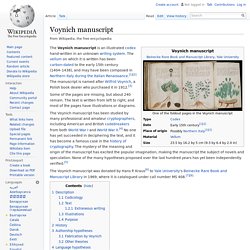
The vellum on which it is written has been carbon-dated to the early 15th century (1404–1438), and may have been composed in Northern Italy during the Italian Renaissance.[1][2] The manuscript is named after Wilfrid Voynich, a Polish book dealer who purchased it in 1912.[3] Some of the pages are missing, but about 240 remain. M A Y B E Q U A R T E R L Y - Volume V - Issue 1. The All Seeing Eye 1927 - Manly P. Hall. The Manly P. Hall Archive » Concrete & Abstract Factors of the Human Mind. Mundus Subterraneus. Codex Seraphinianus. Codex Seraphinianus, originally published in 1981, is an illustrated encyclopedia of an imaginary world, created by the Italian artist, architect, and industrial designer Luigi Serafini during thirty months, from 1976 to 1978.[1] The book is approximately 360 pages long (depending on edition), and written in a strange, generally unintelligible alphabet.
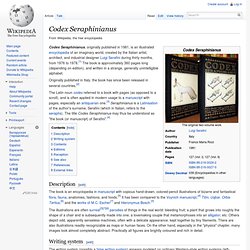
Originally published in Italy, the book has since been released in several countries.[2] Erewhon. The first few chapters of the novel dealing with the discovery of Erewhon are in fact based on Butler's own experiences in New Zealand where, as a young man, he worked as a sheep farmer on Mesopotamia Station for about four years (1860–1864), and explored parts of the interior of the South Island and which he wrote about in his A First Year in Canterbury Settlement (1863).
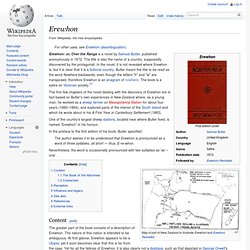
In the preface to the first edition of his book, Butler specified: The author wishes it to be understood that Erewhon is pronounced as a word of three syllables, all short — thus, E-re-whon. Nevertheless, the word is occasionally pronounced with two syllables as 'air – one'. Metamorphoses. The Metamorphoses (Latin: Metamorphōseōn librī: "Books of Transformations") is a Latin narrative poem by the Roman poet Ovid, considered his magnum opus.
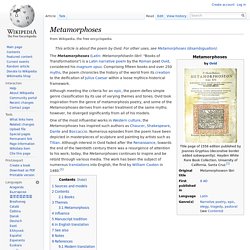
Comprising fifteen books and over 250 myths, the poem chronicles the history of the world from its creation to the deification of Julius Caesar within a loose mythico-historical framework. Although meeting the criteria for an epic, the poem defies simple genre classification by its use of varying themes and tones. Www2.hn.psu.edu/faculty/jmanis/rabelais/rabelais-book1-6x9. Marina Abramović. Marina Abramović (Serbian Cyrillic: Марина Абрамовић; born November 30, 1946) is a Serbian[1][2][3] and former Yugoslav artist based in New York, a performance artist who began her career in the early 1970s.
